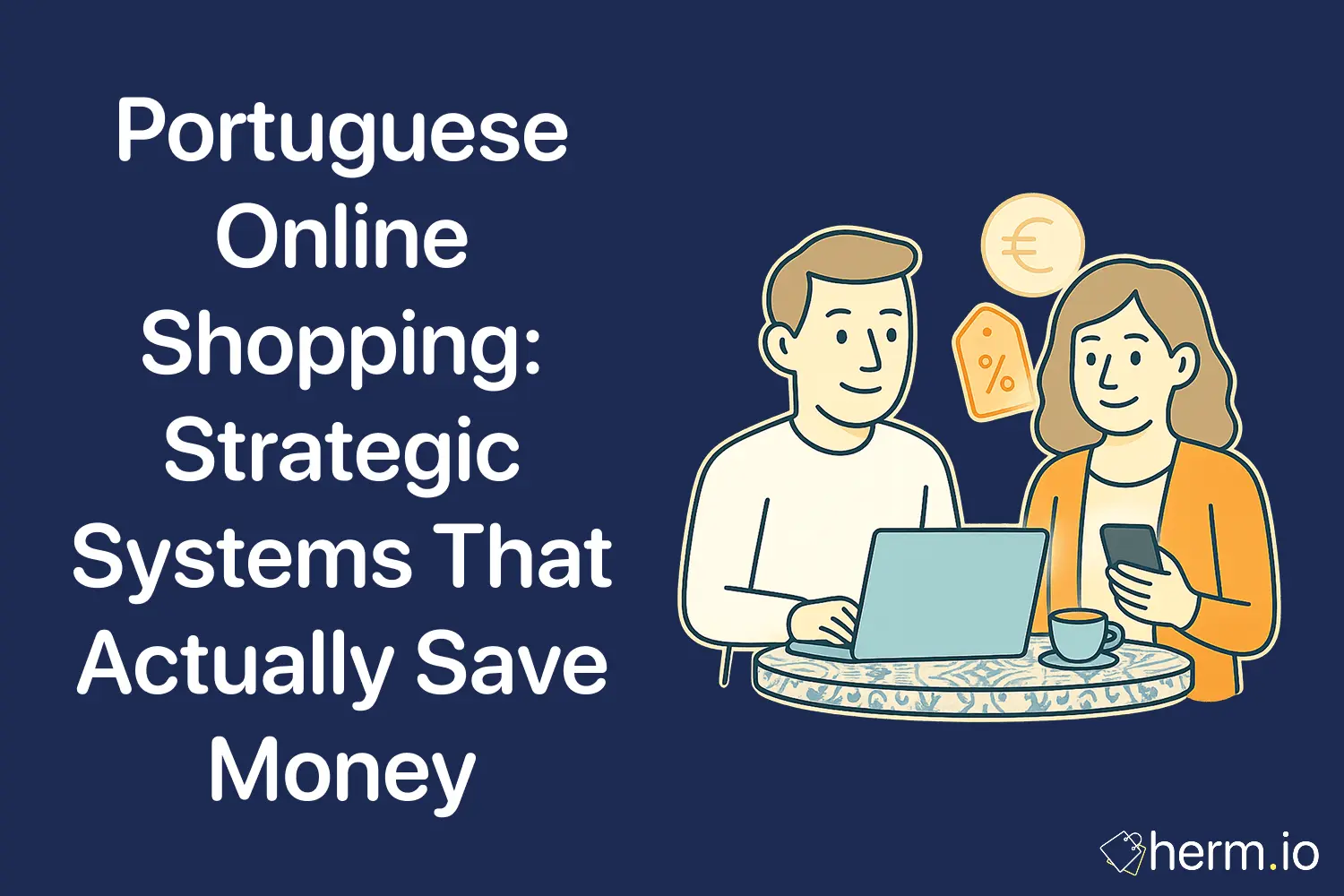
Portuguese online shopping delivers exceptional value when you approach it systematically rather than randomly. The market combines EU consumer protections with aggressive retailer competition, creating pricing inefficiencies you can exploit with the right framework.
Most shoppers waste money on three predictable mistakes: paying for home delivery when pickup points cost nothing, missing the actual sale windows, and comparing prices on only one platform. Fix these three variables and you'll recover £300-500 annually without changing what you buy.
Quick Wins: Implement These Today
- Add KuantoKusta to your bookmarks and check it before every purchase over €30
- Screenshot or save the addresses of your three nearest CTT/DPD pickup points
- Set calendar reminders for Winter Saldos (late December) and Summer Saldos (early July)
- Create a "Portugal Shopping" folder with wishlists at Worten, FNAC, and two local brands you buy from regularly
- Switch your payment default to MB WAY if you have Portuguese banking
The Pickup Point Advantage
Portuguese logistics networks run on pickup points, not home delivery. CTT, DPD, GLS, and courier partners maintain thousands of lockers and partner shops across the country.
The cost differential is significant. Home delivery typically adds €3-7 per order; pickup points cost €0-2, and major retailers offer them free above modest thresholds (usually €20-30). That's €60-100 saved annually if you order twice monthly.
Speed improves too. Pickup points receive consolidated deliveries twice daily in urban areas. Your package often arrives a day earlier than home delivery because couriers don't need to plan residential routes.
Look for "Levantamento em ponto" or "Levantamento em loja" at checkout. These options appear after you enter your postal code. The system shows available points within 2-3 km; choose based on your commute or shopping routes rather than pure distance.
Save three locations in your notes: one near work, one near home, one near your regular shopping area. Include opening hours. This preparation eliminates the checkout scramble where you pick a convenient-sounding location that turns out to require a special trip.
Portuguese Sale Calendar Strategy
Portuguese retail follows a predictable discount cycle. Knowing the calendar prevents paying full price unnecessarily.
Winter Saldos launch after Christmas, typically 27-30 December, and run through February. Target coats, boots, bedding, and appliances. Discounts start at 30% and escalate weekly; the sweet spot hits mid-January when stock remains strong but retailers add deeper cuts to maintain momentum.
Summer Saldos begin early July and extend into August. Focus on sandals, swimwear, fans, portable air conditioning, and summer fashion. Buy next year's hot-weather items in late August at 60-70% off when retailers clear space for autumn inventory.
Black Friday coverage now spans most major retailers. Portuguese shops adopted this event enthusiastically; electronics and fashion see genuine reductions, not artificial "deals." The extension into "Black Week" means you can wait for specific items to hit sale rotation rather than impulse-buying on Friday itself.
Mid-season "Promoções" and "Campanhas" occur when retailers need to move stock between major sales. These unscheduled events often match end-of-season pricing. Subscribe to newsletters from your three most-used retailers; they announce these campaigns 24-48 hours early for subscribers.
Build a wishlist before each sale period. Add items with current prices visible. This creates your baseline for evaluating whether discounts are real or inflated comparative pricing. If that coat costs €89 in November and €79 "reduced from €120" in January, you know the sale is artificial.
Language Navigation Framework
Portuguese shopping sites require minimal language knowledge if you focus on the right terms. These twelve expressions handle 90% of checkout and policy situations:
Deal Identification: "Promoções" (sales), "Outlet" (clearance), "Esgotado" (sold out), "Últimas unidades" (last units available)
Shipping Terms: "Portes grátis" (free shipping), "Levantamento em loja" (store pickup), "Prazo de entrega" (delivery time)
Payment Options: "MB WAY" (Portuguese mobile payment), "Referência Multibanco" (bank reference payment), "Pagamento a prestações" (instalment payment)
Returns Process: "Devoluções" (returns), "Prazo de devolução" (return period), "Trocas" (exchanges)
Most checkout pages highlight these terms in bold or separate boxes. Scroll to the footer for "Envio e Devoluções" (Shipping and Returns) links when you need detailed policy information.
English speakers can navigate Portuguese sites efficiently by pattern recognition. Checkout buttons read "Finalizar compra" or "Pagar" rather than creative variations. Price displays show "€" symbols. Size charts list measurements in centimetres.
When a site lacks English translation, use your browser's built-in translation for policy pages only. Checkout in the original Portuguese to avoid translation errors that could affect your address or payment details.
Marketplace Selection Strategy
Portuguese marketplaces offer different advantages; use them strategically rather than defaulting to one platform.
Worten Marketplace dominates electronics and appliances. Filter by "Vendido e enviado por Worten" (sold and shipped by Worten) for fastest delivery and simplest returns. Third-party sellers expand selection but add complexity. Worten's "flash" and "mega" campaigns occur 2-3 times monthly; sign up for app notifications to catch these six-hour windows.
FNAC Portugal excels at tech, gaming, books, and entertainment. The "Cartão FNAC" loyalty membership (€10-15 annually) pays for itself if you spend €150+ yearly through additional discounts and exclusive pricing. Click & collect works exceptionally well here—most city locations hold orders within four hours.
KuantoKusta isn't a retailer; it's your price verification tool. Search any product above €30 here before buying. The platform lists prices across Portuguese shops, sorts by total cost including shipping, and maintains price history graphs. During major sales, use KuantoKusta to identify which retailer has the genuine lowest price rather than the most prominent banner advertising.
Dott lists thousands of smaller Portuguese sellers and works well for home goods, DIY supplies, and everyday essentials. Prices often undercut major retailers by 15-20% because smaller operators have lower overhead. Verify seller ratings before checkout—look for 95%+ positive feedback and 100+ completed transactions.
Building Your Portuguese Shopping System
Systems beat motivation. A simple framework saves money automatically without requiring constant attention.
Step 1: Infrastructure Setup (15 minutes)
- Bookmark KuantoKusta, Worten, FNAC, and your two most-used local brand sites
- Map and save three pickup point locations with addresses and hours
- Create a "Portugal Shopping" folder in your browser or notes app
Step 2: Wishlist Protocol (5 minutes per item)
- Add any purchase over €30 to wishlists at two retailers before buying
- Note the current price and date added
- Set a reminder for the next sale period if the item isn't urgent
Step 3: Price Verification (2 minutes per purchase)
- Check KuantoKusta for your target item
- Compare the top three results including shipping
- Buy from the retailer with the lowest total cost or best return policy
Step 4: Payment Optimization
- Use MB WAY when available (often includes app-only coupons)
- Watch for "portes grátis" (free shipping) thresholds; add a low-cost item to hit the minimum rather than paying €5 delivery
- Choose "Referência Multibanco" for smaller sites if your card gets declined
Step 5: Delivery Selection
- Default to pickup points unless home delivery costs the same
- Choose the location on your regular route, not the nearest one
- Check collection hours before confirming
This system requires minimal maintenance once established. You'll spend less time shopping while achieving better prices through consistent verification and strategic timing.
Consumer Protection Framework
Portuguese online shopping includes strong legal protections. Understanding these rights prevents retailer resistance during returns or warranty claims.
You have 14 days to return most online purchases without explanation (direito de livre resolução). This period starts when you receive the item, not when you order. Initiate returns within this window through the retailer's website—most provide printable labels or pickup point drop-off options.
Retailers must refund your purchase price plus original shipping costs within 14 days of receiving the return. You pay return shipping unless the item is defective or incorrectly described. Pickup point returns typically cost €2-4, far less than arranging courier collection.
Consumer goods include legal warranties requiring retailers to repair, replace, or refund defective products. Keep your digital invoice ("fatura") in a dedicated email folder or cloud storage. Reference this when claiming warranty service; retailers may try to redirect you to manufacturers, but Portuguese law makes the seller responsible.
The "Livro de reclamações" (official complaints book) is a powerful tool. Every retailer must provide access to this system, even online. Mention it when service issues aren't resolved quickly; most retailers escalate your case immediately rather than risk a formal complaint that requires regulatory response.
Regional Optimization
Portuguese shopping strategy varies by location. Mainland shoppers have the full network; island residents need additional planning.
Lisbon and Porto: Urban density means abundant pickup points and next-day service on in-stock items. Choose click & collect near metro stations or business districts. Major retailers offer same-day pickup for orders placed before 14:00.
Madeira and Azores: Look for clear "ilhas" (islands) policies during checkout. Delivery takes 5-10 days versus 2-3 days mainland. Some retailers charge €5-10 supplements for island shipping; consolidate orders to hit free shipping thresholds. Pickup points exist but are less dense; verify your nearest location before relying on this option.
Free shipping thresholds often increase for island addresses—€50 instead of €30, for example. Plan bulk purchases of non-perishables (cleaning supplies, toiletries, shelf-stable groceries) to meet these minimums and reduce per-item delivery costs.
FAQ
Which payment method saves the most money?
MB WAY often includes app-only coupons worth €2-5 per transaction at participating retailers. It's instant, secure, and increasingly common for additional discounts. Referência Multibanco works as a backup when cards fail but doesn't offer extra savings. Standard card payments with 3-D Secure are reliable but miss the MB WAY bonus opportunities.
How do I know if a sale discount is genuine?
Add items to wishlists 2-4 weeks before major sale periods and note the listed price. During sales, compare the "previous price" against your recorded price. Many retailers inflate the comparison price to make discounts appear larger. KuantoKusta's price history graphs also reveal artificial markups before sales.
Should I pay for premium loyalty memberships?
Calculate the breakeven point. If FNAC Cartão costs €15 and gives you 10% off, you need to spend €150 annually to break even—then everything after is pure savings. Factor in free shipping benefits too. For retailers you use monthly, memberships typically pay for themselves within 3-4 purchases. For occasional shopping, skip them.
What's the fastest way to resolve return issues?
Start the return within the 14-day window and keep proof of postage. If the retailer delays beyond their stated refund timeline, send a polite message referencing your "direito de livre resolução" (right of withdrawal) and the specific date you initiated the return. Mention the Livro de reclamações if needed; this usually triggers immediate escalation to resolution.
Portuguese online shopping rewards strategic shoppers. The infrastructure exists—pickup points, price comparison tools, predictable sales, strong consumer rights—but you must use it systematically. Map your pickup points this week, bookmark KuantoKusta, create wishlists at two major retailers, and set calendar reminders for Winter and Summer Saldos. These five actions establish the framework that saves £300-500 annually through better prices, lower shipping costs, and strategic timing. Start with one purchase using this system; you'll see why systematic beats spontaneous every time.

Élodie Claire Moreau
I'm an account management professional with 12+ years of experience in campaign strategy, creative direction, and marketing personalization. I partner with marketing teams across industries to deliver results-driven campaigns that connect brands with real people through clear, empathetic communication.

.png)








.png)

.png)
.png)
.png)